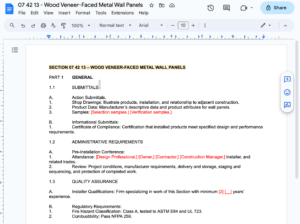Building Product Manufacturers (BPM’s) have become accustomed to seeing their sustainable product documentation included in 3-part guide specifications for many years. The process of listing sustainability product credits for LEED, CHPS, LBC, WELL, and other project sustainability requirements makes the specification process much more involved than it needs to be and adds pages of unnecessary information when specifying sustainable construction products.
We believe sustainability consultants originated this practice. Specifiers are more focused on the 4 C’s of specifications (clear, concise, complete, and correct) and the basic principle of Division 01 – General Requirements (see separate article on “Division 01 Concept), which is “say it once and say it right.”

Instead of relying on statements in Division 01 that govern all sustainable requirements and submittals, sustainability consultants recommend listing all sustainable requirements in each section “because they are important.” Let’s face it, everything in Division 01 is essential, but we can’t repeat those hundreds of pages in each section.
Most BPM’s are familiar with the LEED (Leadership in Energy and Environmental Design) rating system by the U.S. Green Building Council (USGBC). They may not know that USGBC does not have an exclusive on sustainable rating systems. There are other systems, including Living Building Challenge (LBC), Collaborative for High Performance Schools (CHPS.net), State and Local Codes, and corporate standards. California’s CALGreen is an excellent example of a state-required green building code.
How does LEED affect sustainable construction product specifications?
Under previous versions of the LEED system, individual specification sections needed to specify particular sustainable product attributes, such as percent recycled content, VOC limits, etc., Version 4.0 changed all that. All new LEED-certified projects are now under Version 4.0.
Under Version 4.0, sustainable requirements are now primarily specified in Division 01. The responsibility for compliance is placed on the Contractor or Construction Manager. For example, the Contractor or Construction Manager is now directed to use a minimum number of products that meet specific sustainable requirements. It is up to the Contractor or Construction Manager to decide which products to use.
LEED 4.0 also adds several new documents that may need to be submitted as sustainable product submittals, including Environmental Product Declarations (EPD) and Health Product Declarations (HPD). Still, these submittals are required during construction and are not typically a part of product specification.
Where should you document your sustainable construction products?
Clear guidance on sustainability documentation on a website will go a long way. Sustainability documentation is used during product research to locate the desired product and later in the construction process as a submittal. Creating a separate web page on the company website is the best way to supply sustainability documentation.
Also, listing products in sustainability databases, like the Collaborative for High Performance Schools (chps.net), will assist design professionals and contractors during the design and project certification process.
Specifying sustainable construction products
For design professionals looking to update their office master specifications to avoid the pitfall of specifying sustainable construction product documentation requirements in each specification section, we recommended updated Division 01 documentation. By specifying the sustainable design requirements in Division 01, you’ll avoid the complexity of specifying sustainability documentation in each section. Also, making it easier to transition from one sustainability system to the next.
How can ZeroDocs help?
Our SimpleSpecs™ master specification system includes Division 01 sections necessary to specify project requirements for LEED and Collaborative for High Performance Schools (chps.net) projects.
ZeroDocs provides clear guidance on improving 3-part specifications during spec writing services and has partnered with CHPS to develop a pre-approved product database for building product manufacturers.



